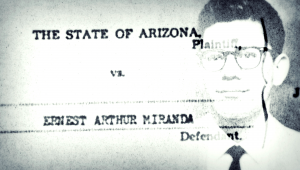
“You have the right to remain silent….” Anyone who has seen a cop show in the past half century knows the rest. This phrase is called the Miranda warning, and it comes from a Supreme Court opinion that was announced 51 years ago today. Miranda v. Arizona established the idea that criminal defendants must be informed of their rights to an attorney and against self-incrimination prior to interrogation in order for any of their statements to be admissible in court.
In 1963, Ernesto Miranda was arrested and charged with kidnapping, rape and armed robbery. After he was picked out in a police lineup, Miranda was subjected to a prolonged interrogation, after which he confessed. Miranda, a 9th grade dropout, was not informed of his constitutional rights. Based largely on his confession, Miranda was found guilty and sentenced to 20 to 30 years in prison.
Miranda appealed, and in a 5-4 decision, the Supreme Court ruled that Miranda’s rights had been violated. The language of what would go on to become the Miranda warning was taken nearly word-for-word from the Supreme Court opinion authored by Chief Justice Earl Warren. “He must be warned prior to any questioning,” wrote Warren, “that he has the right to remain silent, that anything he says can be used against him in a court of law, that he has the right to the presence of an attorney, and that, if he cannot afford an attorney one will be appointed for him prior to any questioning if he so desires.”
Learn more in our film The Right to Remain Silent: Miranda v. Arizona.

